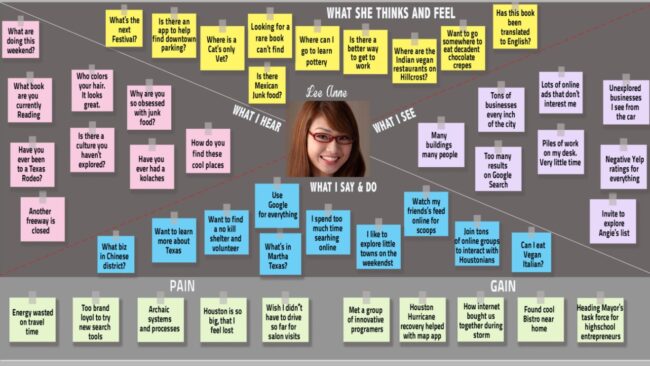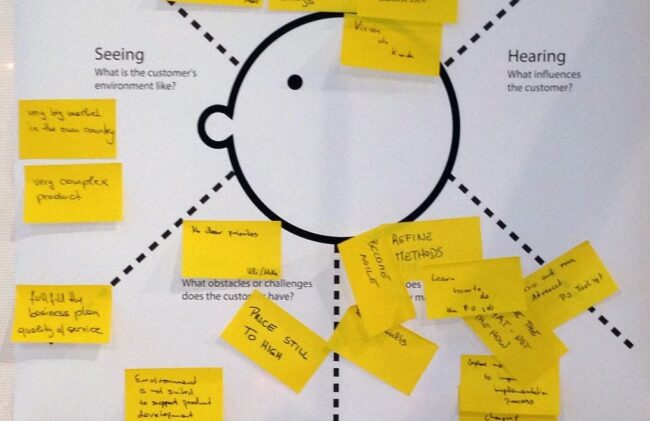Empathy maps are a great tool that marketers can use to understand specific segments within their target audience better. The process involves creating a visual representation of customers’ needs, usually organized in a quadrant under the headings; Says, Thinks, Does, Feels.
Maps like this create an ideal customer persona by helping visualize the behaviors and attitudes of customers. The practice is beneficial as it can be a particularly effective tool for informing colleagues about customers’ needs.
In this article, we answer common questions such as; what is an empathy map, and how to create an empathy map.
What Are Empathy Maps?

Empathy maps are a marketing tool for gaining a better understanding of specific segments within your target audience. Although both are methods that marketers use to build a picture of their customers, empathy maps differ from customer personas.
The difference is in the area of focus. Customer personas tend to identify top-level demographics such as socioeconomic status, marital status, and life stage, whereas empathy maps are a method for visualizing customers’ behaviors and attitudes.
Empathy maps aim to allow marketers and other employees to understand customers better. By understanding customers deeper, you and your colleagues can more effectively put yourself in their shoes. Likewise, by empathizing with your customers, you can meet their needs more effectively. For example, if you’ve determined that your target market usually spends the majority of their time on their phones – like millennials, for example – then you’ll need to come up with strategies that reach them directly and immediately via mobile marketing. SMS business messaging solutions from companies like ClickSend are extremely effective since text messages have open rates of 98%.
Crucially, aside from visualizing what is known about customers, empathy maps are a fantastic way to facilitate collaborative learning. Empathy mapping is a visual process. By articulating learning points alongside images, they create powerful associations in the minds of those taking part in or viewing it.
Think of the power of business brands or logos. As such, businesses often use empathy mapping as a marketing exercise and as a learning tool to share knowledge with other colleagues or the business at large.
It’s, therefore, essential that you use good images and visuals in your empathy maps. Some marketers choose to buy stock illustrations on resources as depositphotos such as icons for their works.
As mentioned above, adding images improves the learning potential of an empathy map by helping the viewer create mental associations. Furthermore, imagery catches the eye and adds balance, ensuring that it doesn’t just become a tangle of written words. Using imagery also makes the exercise a little more fun and engaging.
The Quadrant Headings
The standard empathy map format is a quadrant that consists of the following headings: Says, Thinks, Does, Feels.
Laying these headings out in a quadrant helps your team visualize discrepancies between customers’ beliefs and actions. For example, customers’ words (says) may not always align with their actions (does). Therefore it’s important also to understand what customers think and feel.
Says What do your customers say? Ideally, this quadrant should be populated with direct quotes from consumer research, customer interviews, and focus groups. It also helps to use existing customer testimonials, reviews, and recurring keywords used online.
Thinks What do your customers think? What could they be thinking about your brand or the buying experience? What goals and motivations, or needs and desires do your customers have for interacting with your brand? What do those types of incentives and desires say about your customers’ values or beliefs about your brand/business/product or service?
Does What do your customers do in terms of the actions they take? What behaviors have you observed in your customers? What possible behaviors can you predict? Feels What emotions might your customers be feeling? A good place to start is to ask, what do customers worry about? It can also help to think about the words they use, their tone of voice, and even their body language.
It’s important to note that you can alter your empathy maps by adding additional headings based on your objectives or specific situation. Some business goals or business operations might require you to add an additional heading to give an at-a-glance overview of customers; it’s therefore not necessary to complete each quadrant sequentially or chronologically.
If you’re unsure about where to place a data point, under the thinks or feels quadrant, don’t worry too much. This exercise is about building a detailed picture so add in as much detail as you can and build a rich picture of your customers.
How to Create An Empathy Map

Now that you understand the core headings, it’s time to begin creating your empathy map. The process can be broken down into 5 key steps:
1. Define The Objective of Your Empathy Map
Are you creating an individual empathy map for one key customer or an aggregate one for a customer segment?
B2B companies will often create an individual empathy map for a specific prospect. This will obviously be much more targeted than an aggregate one focusing on building a customer segment picture.
While defining the objective, you should determine who will be involved in the process. For example, will the process only include the marketing team or have additional colleagues from other departments and teams?
2. Gather Existing Research / Customer Data

You are gathering the materials you’ll need to conduct the mapping process. The scope of your process (size of the group partaking in the process) will also inform the materials you’ll need. For example, are you going to be using a whiteboard or completing the process digitally?
Will you give everyone a hard copy of the template, and allow people to note down their own ideas before encouraging them to contribute and share ideas? Focus on designing a collaborative system in advance, ensuring a creative environment where participants are encouraged to contribute their findings and ideas.
3. Gather Customer Data & Research
You’ll need to collate the research and customer data that will inform your empathy mapping process. Most of your customer data should come from qualitative research methods such as interviews, focus groups, and in-depth field surveys.
Of course, these types of sources of data can be supplemented by other sources of customer data, such as online reviews and social media listening. Set up a team that will collect data or encourages participants to come to the empathy mapping session prepared.
4. Begin The Mapping Process

Proceed with the mapping process by encouraging all participants to go through the research and data sources. It’s important to remind participants that their contributions should be informed by the data, not by gut feeling. After participants have had a chance to study the data and come up with points for each heading, encourage them to contribute their ideas for each quadrant heading.
5. Confirm & Polish
The final stage is reviewing all of the data points added under each heading. Next, confirm points with the team by asking for anecdotal evidence that can add another layer of detail to certain points.
Some points may be removed if there isn’t a consensus amongst participants, or they present contradictory evidence. The final step is to polish your empathy map. This might be digitizing the final map so that you can distribute it amongst participants or for easier access at a later date.
